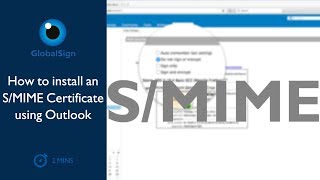Installing an SMIME email certificate in Outlook can provide a secure and encrypted communication channel for your email correspondence. Whether you are an individual or part of an organization, using an SMIME email certificate offers various advantages in terms of privacy, authenticity, and data integrity.
There are two main types of SMIME email certificates: personal and organizational. Personal certificates are issued to individuals for their personal email accounts, while organizational certificates are issued to entities such as companies or organizations for their employees’ email accounts.
To install an SMIME email certificate in Outlook, certain requirements must be met. First, you need a valid email account that supports SMIME certificates. you need an email client, such as Microsoft Outlook, that is compatible with SMIME. You need to obtain an SMIME email certificate from a trusted certificate authority.
In this step-by-step guide, we will walk you through the process of installing an SMIME email certificate in Outlook. The steps include:
- Launching Outlook
- Accessing Outlook options
- Opening the Trust Center
- Navigating to the Email Security Settings
- Importing the SMIME certificate
- Configuring the trust settings for the certificate
While the installation process is generally straightforward, there are a few common issues that you may encounter. These include compatibility issues with the certificate format, dealing with password-protected certificates, and resolving certificate revocation issues. Understanding these troubleshooting tips can help you overcome any challenges that may arise during the installation process.
By following this comprehensive guide and addressing any potential issues, you can successfully install an SMIME email certificate in Outlook and enjoy the benefits of secure and private email communication.
Key takeaway:
- SMIME Email Certificates enhance email security: Using SMIME Email Certificates helps protect your email communication by providing encryption and digital signatures. This ensures the confidentiality and integrity of your emails.
- Various types of SMIME Email Certificates: You can choose between personal SMIME Email Certificates for individual users or organizational SMIME Email Certificates for entire organizations, depending on your needs.
- Requirements for installation: To install an SMIME Email Certificate in Outlook, you need a valid email account, a compatible email client, and obtain an SMIME Email Certificate from a trusted certificate authority.

Why Should You Use an SMIME Email Certificate?
Why Should You Use an SMIME Email Certificate?
Using an SMIME email certificate offers numerous advantages for secure communication.
1. Ensuring Sensitive Information Protection: An SMIME email certificate encrypts both your emails and attachments, effectively preventing unauthorized access to any confidential information. This provides a safeguard for personal and professional data against potential cyber threats.
2. Verified Sender Identity: When utilizing an SMIME email certificate, each of your emails is equipped with a digital signature that confirms your identity as the sender. Recipients can then verify the authenticity of your communication, therefore ensuring the integrity of emails during transit.
3. Establishing Trust and Credibility: By employing an SMIME email certificate, you showcase your dedication to secure communication. This enhances your reputation, particularly in dealings with clients, partners, or colleagues who prioritize data privacy and security.
4. Compliance with Regulatory Standards: Various industries, such as healthcare and finance, have stringent regulations concerning data protection. An SMIME email certificate assists in meeting these compliance standards by fulfilling email encryption and authentication requirements.
5. Seamless Integration: SMIME email certificates seamlessly integrate with popular email clients such as Outlook. This makes it easy to incorporate them into existing workflows, enabling secure email communication without disrupting productivity.
Types of SMIME Email Certificates
Discover the fascinating world of SMIME email certificates and explore the different types available. From personal SMIME email certificates to organizational ones, each sub-section holds its own unique benefits and functionalities. Get ready to enhance your email security and encryption with these essential tools. So, whether you’re an individual looking to protect your personal correspondence or an organization ensuring secure communication across the board, this section has got you covered. Get ready to dive into the realm of SMIME email certificates and unlock a world of secure communication possibilities.
1. Personal SMIME Email Certificates
Personal SMIME email certificates play a crucial role in ensuring the confidentiality and integrity of your email communications. These certificates provide strong encryption that effectively shields your messages from unauthorized access. When you obtain a personal SMIME email certificate, you can be confident that only the intended recipient will be able to read your emails.
Trusted Certificate Authorities (CAs) are responsible for issuing these certificates and validating the identity of the applicant. This validation process adds an extra layer of security and prevents any possibility of impersonation.
In addition to encryption, personal SMIME email certificates also allow you to digitally sign your emails. This digital signature serves as proof of the email’s authenticity and integrity, providing recipients with assurance that the email has not been tampered with.
It is important to keep in mind that personal SMIME email certificates have a validity period ranging from one to three years. After this period, it is necessary to renew the certificate in order to continue benefiting from its advantages.
By utilizing personal SMIME email certificates, you can significantly enhance the security of your email communications and establish trust with your recipients.
2. Organizational SMIME Email Certificates
Organizational SMIME Email Certificates play a critical role in safeguarding communication and protecting sensitive information for businesses and organizations. These certificates are essential as they are issued to the entire organization, enabling all members to securely send and receive encrypted emails.
Organizational SMIME Email Certificates offer several benefits:
- Enhanced Security: These certificates ensure data security by encrypting email messages during transmission.
- Brand Identity Protection: Organizations can protect their brand and validate their identity, guarding against phishing attacks and impersonation.
- Compliance with Regulations: Organizational SMIME Email Certificates help companies adhere to strict regulations regarding the protection of sensitive data.
- Simplified Management: By obtaining an organizational certificate, the process becomes streamlined, reducing administrative overhead compared to individuals managing their own certificates.
- Cost-Effective: Organizational certificates eliminate the need for employees to purchase individual certificates, resulting in cost savings for the organization.
These certificates enhance overall security, foster customer trust, and minimize the risk of data breaches. They facilitate secure communication within and beyond the organization, preserving the integrity of shared sensitive data via email while protecting confidential information.
It is crucial for organizations to ensure that their email clients are compatible with organizational SMIME Email Certificates before implementing them. Individuals within the organization should follow the necessary steps to obtain and install these certificates to fully access their benefits.
Requirements for Installing SMIME Email Certificates
To successfully install an SMIME email certificate in Outlook, there are a few key requirements you need to meet. We’ll dive into each of them, so you know exactly what you’ll need before getting started. First, having a valid email account is crucial. You’ll need a compatible email client that supports SMIME. And finally, obtaining an SMIME email certificate is a vital step in the process. So, let’s break down these requirements and get your SMIME email certificate up and running in no time!
1. Valid Email Account
When it comes to installing an SMIME email certificate, a valid email account is the first requirement. It is important to consider the following factors:
1. Choice of Email Provider: It is recommended to use a reputable email provider such as Gmail, Outlook, or Yahoo as they fully support SMIME email certificates.
2. Account Activation: Make sure your email account is active and easily accessible. It is essential to verify that you can log in and send/receive emails without any difficulties.
3. Domain Verification: Depending on the type of SMIME email certificate you choose, you may be required to provide domain verification as evidence of ownership. This is particularly necessary for organizational certificates.
4. Security of Connection: To safeguard the privacy and integrity of your communication, it is advisable to configure your email account with secure connection settings like SSL or TLS.
Having a valid email account is absolutely vital for the successful installation and utilization of an SMIME email certificate. By doing so, you can enhance the security of your email communication and ensure that your messages remain confidential.
2. Compatible Email Client
Installing an SMIME email certificate requires a compatible email client. When choosing an email client for SMIME email certificates, it is important to consider compatibility. Ensure that your email client supports SMIME. Examples of compatible email clients include Microsoft Outlook, Mozilla Thunderbird, and Apple Mail. Check if your email client version supports all SMIME features or if it requires additional configurations. Verify if your operating system meets the requirements of both the email client and the SMIME certificate. It is also important to make sure your email client supports SMIME on mobile devices and allows certificate installation and management. Keep in mind that some email clients may require additional plugins or extensions to enable SMIME, so always check for compatibility. By ensuring compatibility between the email client and the SMIME certificate, you can securely communicate via email and benefit from SMIME encryption.
3. Obtaining an SMIME Email Certificate
Obtaining an SMIME Email Certificate involves several steps:
1. Choose a trusted Certificate Authority (CA) that issues SMIME Email Certificates.
2. Visit the CA’s website and select the type of SMIME Email Certificate you need: personal or organizational.
3. Provide the necessary information to the CA, including your name, email address, and organization details (if applicable).
4. Verify your identity by following the CA’s instructions, which may include providing identification documents or completing an identity verification process.
5. Review and agree to any terms and conditions set by the CA.
6. Pay the required fee for the SMIME Email Certificate.
7. Wait for the CA to issue your certificate. The processing time may vary, but you will receive the certificate and its associated files once it’s ready.
8. Download and save the certificate files to a secure location on your computer.
9. Ensure that your email client is compatible with SMIME Email Certificates. Most popular email clients, such as Outlook, support SMIME certificates.
10. Follow the installation instructions provided by your email client to import the SMIME Email Certificate and configure its settings.
11. Test the installation by sending a digitally signed and encrypted email to another recipient with a compatible email client.
By following these steps, you can successfully obtain and install an SMIME Email Certificate, allowing you to send and receive secure and authenticated emails.
Step-by-Step Guide: How to Install an SMIME Email Certificate in Outlook
Looking to secure your emails with an SMIME email certificate in Outlook? This step-by-step guide has got you covered! We’ll walk you through each stage, from launching Outlook to configuring the trust settings for the certificate. Get ready to enhance the security and authenticity of your email communications. No more worrying about unauthorized access or tampering. Let’s dive in and learn how to install an SMIME email certificate in Outlook like a pro!
1. Launching Outlook
Edited
- Launching Outlook
- Open your computer and go to the desktop.
- Double-click the Outlook icon to open the application.
- Once Outlook opens, you will see the main interface with your inbox, folders, and options.
- In the top menu bar, click “File” and select “Options” from the drop-down menu.
- A window titled “Outlook Options” will appear.
- In the left sidebar, click “Trust Center”.
- In the main section of the Trust Center, click “Trust Center Settings”.
- A window titled “Trust Center” will open, displaying security options.
- In the Trust Center window, click “Email Security” in the left sidebar.
- In the main section, you will find email security settings.
- Scroll down to the section for certificates.
- Click the “Settings” button in the certificates section.
- A window will appear, showing the installed certificates in Outlook.
- To import an SMIME email certificate, click “Import/Export”.
- Follow the prompts to locate and import your SMIME email certificate file.
- Once the certificate is imported successfully, click “OK” to close the windows and save the changes.
- You have now successfully launched Outlook and imported your SMIME email certificate.
2. Accessing Outlook Options
Here’s how to access Outlook options:
- Launch Outlook: Open the Outlook application on your computer.
- Access Outlook Options: Click the File tab at the top left corner of the Outlook window. This opens the backstage view.
- Open Trust Center: In the backstage view, click the Options category on the left sidebar. This opens the Outlook Options window.
- Navigate to Email Security Settings: In the Outlook Options window, click the Trust Center tab on the left sidebar. Then, click the Trust Center Settings button on the right side of the window.
- Import the SMIME Email Certificate: In the Trust Center window, click the Email Security tab on the left sidebar. Then, click the Import/Export button in the Encrypted Email section.
- Configure Trust Settings for the Certificate: In the Import/Export Wizard window, select the option to import the certificate file. Browse for the location where the SMIME email certificate is saved on your computer and select the file. Follow the prompts to complete the import process.
By following these steps, you can easily access Outlook options and install an SMIME email certificate.
3. Opening the Trust Center
Opening the Trust Center in Outlook is a crucial step when installing an SMIME Email Certificate. Follow these steps to easily access the Trust Center:
1. Begin by launching Outlook.
2. To access Outlook Options, simply click on the “File” tab located at the top-left corner of the window. From the drop-down menu, select “Options.”
3. In the Outlook Options window, navigate to the “Trust Center” tab.
4. Within the Trust Center, you can find the Trust Center Settings button. Click on it to open the Email Security Settings.
5. Inside the Trust Center settings, locate the “Email Security” tab. Click on it, then select “Import/Export” in the “Digital IDs (Certificates)” section.
6. By following the instructions provided by the import wizard, you can easily import the SMIME Email Certificate (.p12 or .pfx file). Adjust the trust settings according to your personal preferences to configure the Trust Settings for the Certificate.
Remember, the Trust Center in Outlook plays a vital role in effectively managing the security and privacy settings of your email communication. By properly configuring the Trust Center and importing an SMIME Email Certificate, you can enhance the security and authenticity of your email correspondence.
4. Navigating to the Email Security Settings
To access the email security settings in Outlook, follow these steps:
1. Launch Outlook.
2. Click on the File tab in the top left corner of the Outlook window and select “Options” from the dropdown menu to navigate to Outlook Options.
3. In Outlook Options, go to the left sidebar and click on “Trust Center” to open the Trust Center.
4. Inside the Trust Center, navigate to the Email Security settings by clicking on “Email Security” in the navigation pane on the left side.
Within the Email Security settings, you will find options to manage the security of your emails, including features like encryption and digital signatures. Here, you can specify default security settings for both sending and receiving messages, as well as manage certificates and encryption algorithms.
Navigating to the email security settings is crucial for protecting and securing your emails. By configuring the appropriate security settings, you can safeguard sensitive information and prevent unauthorized access to your emails. Utilizing encryption and digital signatures can verify the authenticity of your emails and shield them from tampering.
By following these steps and accessing the email security settings in Outlook, you have the ability to control the security measures for your emails, ensuring safe and protected communication.
5. Importing the SMIME Email Certificate
Importing the SMIME Email Certificate in Outlook involves several steps to properly install and use the certificate for secure email communication.
1. Launch Outlook: Open the Outlook application.
2. Access Outlook Options: Click the “File” tab and select “Options”.
3. Open the Trust Center: In the Outlook Options window, select “Trust Center”.
4. Navigate to Email Security Settings: In the Trust Center, click “Trust Center Settings” and select “Email Security”.
5. Import the SMIME Email Certificate: In the Email Security settings, click “Import/Export”. Choose to import the SMIME Email Certificate and locate the certificate file on your computer. Follow the prompts to complete the import process.
6. Configure Trust Settings for the Certificate: After importing the certificate, ensure it is selected in the “Digital IDs (Certificates)” section. Adjust the trust settings for the certificate according to your preferences, such as automatic encryption or signing of outgoing messages.
Importing the SMIME Email Certificate is crucial for secure email communication. It encrypts and authenticates emails, providing enhanced privacy and security. Follow the above steps to import the certificate into Outlook for your email correspondence.
6. Configuring the Trust Settings for the Certificate
When configuring the trust settings for the certificate in Outlook, follow these steps:
1. Launch Outlook.
2. Access Outlook Options.
3. Open the Trust Center.
4. Navigate to the Email Security Settings.
5. Import the SMIME Email Certificate.
6. Configure the Trust Settings for the Certificate.
Configuring the trust settings for the certificate is important to ensure the security and integrity of your emails. By configuring the trust settings, you can verify that the sender’s email address has not been tampered with and that the email has been encrypted using a trusted certificate. This helps protect your sensitive information and prevents unauthorized access to your emails.
Troubleshooting Common Issues when Installing SMIME Email Certificates
Are you having trouble installing SMIME email certificates in Outlook? Don’t worry, we’ve got you covered! In this section, we will tackle the most common issues that arise during the installation process. From certificate format compatibility to dealing with password-protected certificates, and even certificate revocation issues, we’ll explore each sub-section to help you troubleshoot effectively. Say goodbye to installation headaches and get ready to enjoy the seamless use of SMIME email certificates in Outlook.
1. Certificate Format Compatibility
When dealing with the installation of an SMIME email certificate, one crucial factor to take into account is the compatibility of the certificate format. The different formats of certificates can have varying degrees of compatibility with different email clients, which can directly impact the successful installation and use of the certificate. Below you will find a table illustrating the compatibility of various certificate formats with commonly used email clients:
| Certificate Format | Outlook | Gmail | Apple Mail |
|---|---|---|---|
| X.509 (.cer) | Yes | No | Yes |
| P7B (.p7b) | Yes | Yes | No |
| PFX/PKCS12 (.pfx, .p12) | Yes | No | Yes |
As the table demonstrates, the X.509 format is compatible with Outlook and Apple Mail but not Gmail. The P7B format is compatible with both Outlook and Gmail but not Apple Mail. The PFX/PKCS12 format is compatible with Outlook and Apple Mail but not Gmail.
To guarantee a successful installation of an SMIME email certificate, it is highly recommended to use a format that is compatible with the specific email client you intend to use. If you require the certificate to function with multiple email clients, it may be necessary to obtain a format that is compatible with all of them.
Considering the compatibility of the certificate format will ensure a smooth installation and seamless utilization of your SMIME email certificate with your chosen email client(s).
2. Password-Protected Certificates
Password protection plays a crucial role in ensuring the security of SMIME email certificates. It adds an extra layer of protection to your email communications, ensuring that only authorized individuals can access your encrypted messages.
There are several benefits of using password-protected certificates:
1. Enhanced Security: Password protection makes it significantly more difficult for hackers or malicious individuals to decipher your encrypted emails.
2. Confidentiality: Password protection ensures that only those with the correct password can read the content of your encrypted emails. This guarantees the privacy of your sensitive information.
3. Control: By utilizing a password to protect your certificate, you maintain complete control over who can access your encrypted messages.
4. Flexibility: Password-protected certificates enable you to securely send encrypted emails to recipients who may not possess their own SMIME certificates or public keys.
It is worth emphasizing that organizations recognize the importance of password-protected certificates. In fact, a study conducted by the Ponemon Institute found that 63% of organizations incorporate password-protected certificates as part of their email encryption strategy. This statistic highlights the significance of this security measure in safeguarding sensitive information.
3. Certificate Revocation Issues
Certificate revocation issues can have a significant impact on the security and functionality of SMIME email certificates. It is crucial to be aware of these issues to ensure smooth certificate management. Here are some common problems related to certificate revocation and how to address them:
1. Chain of Trust Verification: One issue that may arise is the failure to establish the chain of trust for the certificate. This occurs when the recipient’s email client does not recognize or trust the issuing certification authority (CA). To resolve this, make sure the CA is trusted and install its root certificate correctly on the recipient’s system.
2. Incorrect or Expired Certificates: Sometimes, the certificate itself may be expired or contain incorrect information. This can lead to revocation issues as the recipient’s email client may reject the certificate due to these inconsistencies. It is important to regularly check and update certificates to avoid such problems.
3. Certificate Revocation Lists (CRLs): CRLs are used to revoke compromised or invalid certificates. Using an outdated CRL or failing to fetch the latest CRL can result in revocation problems. To mitigate this issue, ensure that the email client is configured to regularly update and fetch the latest CRLs.
4. Online Certificate Status Protocol (OCSP) Responder Issues: OCSP provides real-time certificate status verification. If the OCSP responder is unavailable or if its response is not retrieved properly, it can cause certificate revocation issues. To address this, configure the email client to use multiple reliable OCSP responders.
By being aware of these certificate revocation issues and taking appropriate measures such as regularly updating certificates and correctly configuring the email client, users can ensure the proper functioning and security of their SMIME email certificates.
Some Facts About How to Install an S/MIME Email Certificate in Outlook:
- ✅ Installing an S/MIME certificate is a process that adds a layer of security to Outlook email.
- ✅ S/MIME certificates can be obtained from a Certificate Authority (CA) or Actalis, an Italian CA.
- ✅ The S/MIME certificate can be in the form of a PKCS #12 file (.p12 or .pfx) or a PKCS #7 file (.p7b).
- ✅ To install the S/MIME certificate in Outlook, the user needs to go to File > Options > Trust Center > Trust Center Settings > Email Security and import the certificate.
- ✅ Once set up, the user can send digitally signed and encrypted emails using Outlook with the S/MIME certificate.
Frequently Asked Questions
How do I install an S/MIME email certificate in Outlook on Windows 10?
To install an S/MIME email certificate in Outlook on Windows 10, follow these steps:
1. Download the certificate from the provided Certificate Activation Link email.
2. Create a password for the certificate and save the PKCS#12 file.
3. Open Outlook Options and go to Trust Center > Trust Center Settings > Email Security.
4. Click on Import/Export under Digital IDs (Certificates) and browse for the PKCS#12 file.
5. Enter the password and click OK to import the certificate.
6. Configure the encrypted email settings, including the signing and encryption certificate.
7. Start sending signed and encrypted messages in Outlook.
Can I install an S/MIME certificate in Outlook without administrator approval?
Yes, you can install an S/MIME certificate in Outlook without administrator approval. Follow the instructions provided in the installation guide to download, import, and configure the certificate in Outlook. For enterprise accounts, it is recommended to seek administrator approval for the smooth implementation of S/MIME certificates.
How to verify if the S/MIME certificate is successfully installed in Outlook?
To verify if the S/MIME certificate is successfully installed in Outlook, follow these steps:
1. Open Outlook Options and go to Trust Center > Trust Center Settings > Email Security.
2. Click on Settings under Encrypted email to view the installed certificates.
3. Ensure that the desired certificate is listed as the signing and encryption certificate.
4. If the certificate is not listed, follow the installation instructions again carefully.
What are the limitations of using S/MIME in Outlook on the web?
The limitations of using S/MIME in Outlook on the web include:
1. It requires a Windows desktop device and is not available on Mac, iOS, Android, or other non-Windows devices.
2. S/MIME might not be available for all accounts, as its availability depends on the account settings and type.
3. S/MIME digital signatures are only fully supported for recipients within the organization, and recipients outside the organization may not be able to verify the digital signature.
How can I exchange secure emails with a contact in Outlook?
To exchange secure emails with a contact in Outlook, follow these steps:
1. Send a signed email message to the contact and prompt them to send a digitally signed email back.
2. Allow the storage of the contact’s public key when prompted.
3. Add the contact to Outlook Contacts by right-clicking on their name in an email and selecting “Add to Outlook Contacts.”
4. Save and close the contact.
5. Encrypted emails can now be exchanged with the contact using their secure email certificate.
Can I use S/MIME encryption and digital signatures in Outlook on Windows 10 Enterprise?
Yes, you can use S/MIME encryption and digital signatures in Outlook on Windows 10 Enterprise. Follow the installation guide provided to install the S/MIME certificate and configure the encryption and signing settings in Outlook. Ensure that you have the required administrative permissions and access to the necessary resources within your organization’s work or school domain for seamless implementation.





